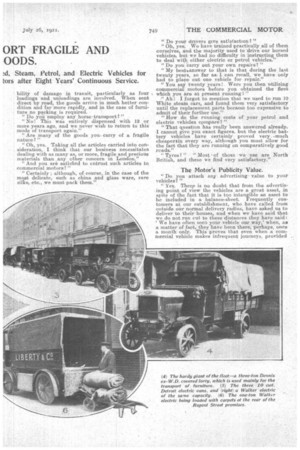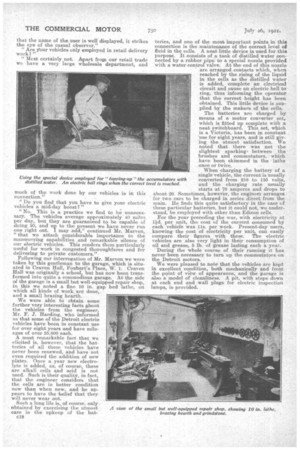ORT FRAGILE AND • OODS.
Page 15

Page 14

Page 16

If you've noticed an error in this article please click here to report it so we can fix it.
The Experiences of Liberty and Co., Lt( Carrying Goods. The Condition of Edi: :d, Steam, Petrol, and Electric Vehicles for tors after Eight Years' Continuous Service.
TO PRACTICALLY all Londoners and to a tremendous number of people outside the Metropolis the name of Liberty is almost a household worct, and is associated with high-class furniture and interior decorating, beautiful silks, carpets from all over the world, articles of vertu, artistic china and glassware silverware, etc. Naturally, a company dealing with such a wonderful range of marketable goods requires a considerable fleet of vehicles for their transport, and as many of the goods are of a most fragile nature, their transport should be of particular interest to many of our readers who deal with similar loads. By the courtesy of the directors of the company and the help of Mr. C. Marven, the transport manager, we were able to obtain an interview with the latter gentleman, whom we found situated in the midst of a hive of activity behind the main building in Regent Street. So busy was the scene, that we hardly liked interrupting Mr. Marvell in order to ask hirn some questions, but we have found, curi ously enough that the busiest men, owing to careful organization, are usually able to spare us more time than those who have, in actual fact. a less strenuous time, .
The Liberty Fleet
"Of what does your fleet consist?" question. "We have both electric and petrol vehicles," replied Mr. Marven. " Of the electric vehicles there are six, consisting of 10 cwt. and 1-ton machines. All are provided with Edison alkali accumulators, and they are of two makes—Detroit and Walker; the former are all of 10 cwt. capacity, as are two of the Walkers, whilst the remaining Walker is a onetonner. All the electrics were supplied by Electricars, Ltd., as the company is . now named. Of the petrol there are five machines, three being 1-ton Albions, one a 30-mt. Albion, and the fifth a 3-tore Dennis. One of the electrics we have had since 1913, whilst two were purchased in 1914; the other three we obtained in 1919. .;.The,oldest Albionf was was our first purchased in 1912, and the Dennis (which, incidentally, is an ex-W.D. vehicle) was obtained in 1919. All these vehicles, with the exception of the Dennis lorry, are kept in our garage, the Dennis is kept at our cabinet factory." "Why do you .run ,both petrol and electric vehicles I " "Well, we find that for town work there is nothing to compare with the electric vehicle from all points of view, including the cost of upkeep, the power required, and the wear on tyres, but, of course, the radius of action of the electric vehicle is limited—in our case to 40 miles per day, and, therefore, we employ petrol vehicles for the longer distances; in fact, we run these to all parts of the country, particularly in the case of bulky goods, such as loads of furniture. We find it much cheaper to send such load's by road to any distance, as, if sent by rail, the furniture has to be ,expensively packed, and even then there is considerable possi bility of damage in transit, particularly as four loadings and unloaclings are involved. When sent direct by road, the goods arrive in much better condition and far more rapidly., and in the case of furniture no packing is required. "Do youemploy any horse,transport?"
"No! This was entirely dispensed with 12 or more years ago, and we never wish to return to this mode of transport again." "Are many of the goods you. carry of a fragile nature?"
"Oh, yes. 'Taking all the articles carried into consideration, I think that our business necessitates dealing with as many as, or more, fragile and precious materials than any other concern in London." "And you are satisfied to entrust such articles to commercial motors?"
" Certainly ; although, of course, in the case of the most delicate, such as china and glass ware, rare silks, etc., we must pack them." "Do your drivers give satIsfaction I"
"Oh, yes. We have trained practically all of them ourselves, and the majority used to -drive our horsed vehicles, but we had no difficulty in instructing them to deal with either electric or petrol vehicles."
"Do you carry out your own repairs?"
"My best.tanswer to that is that during the last twenty years, so far as, I can recall, we have only had to plate out one vehicle for repair." "You say twenty years! Were you then utilizing commercial motors before you obtained the fleet which you are at present maiming?"
" Ah! I forgot to mention that we used to run 10 White stean cars, and found them very satisfactory until the replacement parts became too expensive to admit of their further use."
"How do the running costs of your petrol and electric vehicles compare? "
"That question has really been answered already. I cannot give you exact figures. but the electric battery vehicles have certainly proved very much cheapertin every way, although you must allow for the fact that they are running on comparatively good reads."
"Tyres? " "Most of those we use are North British, and these we find very satisfactory."
The Motor's Publicity Value.
" Do you attach any advertising' value to your vehicles? "
"Yes. They is no doubt that from the advertising point of view the vehicles are a, great asset, in spite of the fact that it is too intangible an asset to be included in a balance-sheet. Frequently customers at our establishment, who have called from outside our normal delivery radius, have asked us to deliver to their houses, and when we have said that we do not run cut to these distances they have said: 'We have often seen your vehicle our way,' when, as a matter of fact, they have been there, perhaps, once a month only. This proves that even when a commercial vehicle makes infrequent journeys, provided that the name of the user is well displayed, it strikes the eye of the casual observer."
"Are your vehicles only employed in retail delivery work 1 " " Most certainly not. Apart from our retail trade we have a very large wholesale department, and much of the work done by our vehicles is in this connection."
" Do you find that you have to give your electric vehicles a mid-day boost7" "No. This is a practice we find to be unnecessary. The vehicles average approximately 40 miles per day, but they are guaranteed to be capable of doing 50, and up to the present we have never run one right out. I may add," continued Mr. Marven, "that we attach considerable importance to the manceuvring capabilities and remarkable silence of our electric vehicles. This renders them particularly useful for work in congested thoroughfares and for delivering• to private customers."
Following our interrogation of Mr. Marven we were
• taken by this gentleman to the garage, which is situated in Craven Hall, Foubert's. Place, W. 1. Craven Hall was originally a school, but has now been transformed into quite a commodious garage. At the side a the garage is a small but well-equipped repair shop, in this we noted a fine 10 in. gap bed lathe, on which all kinds of work are done,
and a small brazing hearth.
We were able to obtain some further very interesting facts about the vehicles from the engineer, Mr. F. J. Harding. who informed us that some of the Detroit electric vehicles have been in constant use for over eight years and have mileages of over 55,000 each.
A most remarkable fact that we elicited is, however, that the 'sat teries of all these vehicles have never been renewed, and have not even required the addition of new plates. Once a year new electrolyte is added, as, of course, these are alkali cells and acid is not used. Such is their quality, in fact, that the engineer considers that the cells are in better condition now than when new, and he appears to have the belief that they will never wear out.
Such a long life is, of course, only obtained by exercising the utmost care in the upkeep of the bat C18
teries, and one of the most. important points in this connection is the maintenance of the correct level a fluid in the celle. A neat little device is used for this purpose. It consists of a tank of distilled water eonnected by a rubber pipe to a special nozzle provided with a water-control valve, At the end of this nozzle are arranged contacts which, when:
reached by the rising of the liquid in the cells as the distilled water is added, complete an electrical circuit and cause an electric bell to ring, thus informing the operator that the correct height has been obtained. This little device is supplied by the makers of the cells.
The batteries are charged by means of a motor converter seta which is fitted up complete with a neat switchboard. This set, which is a Victoria, has been in constant 'use for eight years, and is stillgiving the utmost satisfaction. We noted that there was not the slightest sparking, between the brushes and commutators, which have been skimmed in the lathe once or twice.
When charging the ba.ttery of a
single vehicle, the current is usually converted from 210 to 110 volts, and the charging rate usually starts at 70 amperes and drops to about 20. Sometimes, however, the engineer arranges for two cars to be charged in series direct from the main. He finds this quite satisfactory in the case of these particular batteries, but it could not, we understand, be employed with other than Edison cells.
For the year preceding the war, with electricity at lid, per unit, the cost of the current consumed by each vehicle was Ils. per week. Present-day users, knowing the cost of electricity per unit, can easily compare their figures with these. The electric vehicles are also very light in their consumption of oil and grease, 5 lb. of grease lasting each a year. During the whole course of their running it has never been necessary to turn up the commutators on the Detroit motors. We were pleased to note that the vehicles are kept in excellent condition, both mechanically and from the point of view of appearance, and the garage is also a model of cleanliness. A pit, with steps down at each end and wall plugs for electric inspection lamps, is provided.
































